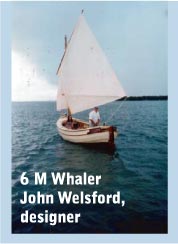| Part One - Part Two
Fitting the Perfect Sail – Part 1, Finding Inspiration
Attempting to find the perfect sail is not dissimilar to discovering the perfect spouse; except for the lucky few who hit upon either with precision and accuracy, the rest of us are doomed to trial and error until the kinks are worked out.
Such was the case in both aspects of my personal and sailboat construction lives. Like most of the population, it took several turns at marriage to discover a wonderful companion. Similarly, only trial, error, and persistence brought within my acute perception the aesthetically thrilling contour of a four cornered sprit sail. A ridiculous number of hours were spent at the drawing board, at the modeling table, and at the computer desk where thousands of online sailboat photos scrolled across a blurry screen, all for the sake of finding one goofy sail.
It might occur to most right thinking folks that if one pays relatively close attention to the intended construction project plans, it is very likely that success will follow, for the drafter has performed in advance most of the hard work; deriving mathematics, sorting out the construction methodology, factoring safety, in addition to offering an attractive solid hull and a nicely suited upper garment; i. e. rigging.
However unfortunate it is for my spouse to have discovered, my nature is not always well suited to right thinking and doing things in accordance with a designer's plan; something for which, I'm relatively affirmed, will provide for lively discussion with any deity I meet in the life hereafter. Moreover, terrestrially speaking, there are circumstances from which my face will react unconsciously with obvious displeasure, contorting un-seemingly into a countenance reminiscent of Wolf-man at feeding time. Such was the case when the sail designed for the 14ft skiff, on which many hours of hard labor have so far been expended, failed to satisfy the synoptic nerve centers reserved for higher order pleasures, such as the arts. It just wasn't what I wanted, after all.
Spending more hours at a drafting board than at the computer keyboard that earns my keep, countless sail patterns born to white parchment dribbled to the floor, the bulk of which heaped to a level well over the knees of Feebee, the street dog we took in, who with the energy of Lassie on pay day sought to treat the crumpled baseballs with contempt, shredding many into the far recesses of difficult to access dark corners. These episodes of canine exuberance frequently caused my spouse's countenance to rearrange unfashionably.
Surmising that perhaps the dog might be feeling something other than playful, easier to reach shreds were retrieved, smoothed, and unsuccessfully examined for signs of willful or accidental inspiration. A few torn patterns were interesting, however, nothing pulled at my halyards more than an ounce or two. I gave Feebee an 'A' for effort and a doggy treat as reward for trying to help the old man - at least HER tail wagged.
 |
Balanced Lug rig |
Modeling sails came next, but my best effort, a balanced lug rig depicted in the photo, which held intense fascination for a number of months, began to look less appealing as the hull progressed. Once the hull was flipped keel down, various temporary rigging structures were erected aboard to test my theorems on rig design. The more effort I gave the project, the more my enthusiasm for the lug rig wavered then waned until darkness enveloped my nautical spirit, much like the void of light that shadows a new moon.
More research, more drawing, more calculations, more headaches. What more could a neophyte boat-builder do? How about a little divine intervention? And that is about as accurate a description of how I found the perfect sail as I can guess. One afternoon, while pondering sails for the umpteenth time, I came across a web page that sought to describe in a well written treatise the Hampton fishing boats of the North-East and their propulsion systems - being at first sail, then engine.
 |
Hampton Boat |
My eyes glanced quickly over the page. The read was of quality, but the minuscule photos gathered little notice. Just before pressing the exit button to extinguish the page forever, I thought momentarily to scroll up to a smallish B&W photo that I perceived from the edge of my eye while reading the text. "By Jove," I said to Feebee, "now that's a chirpy little sail that would look quite splendid flying over CHERRYL!" (CHERRYL is the name chosen for the construction effort still sitting un-baptized in the driveway).
Of course, feeling too bashful to write accurately the expletives drawn out by the excitement - a fairly rough vernacular encouraged through years of public education and US Navy service - be advised that I wrote the above conversation in benign British Doyle-esque rather than risk insulting the reader's sensitivities. It's perfectly obvious that of late I've been reading far too much Sherlock Holmes.
With eyes still bulging and my fingers trembled with anticipation, I lifted the image from the small computer screen, which proved to be a rather straight forward exercise. But that was just the beginning. I soon realized that I lacked the required calculations and math skills to dimension this wonderfully proportioned four sided sprit rig to my own project. To say that my mind was void is a kindness.
CHERRYL's original sloop sail was designed at about 90 ft2, and by Jove, if all that kept me from dimensioning this sprit rig was a little more research and a few practice problems; stand aside Einstein, I'm coming through; damned the torpedoes and full speed ahead.
Have no fear, mariner friends, for I have already perspired over the endeavor to help make easier the process of creating a perfect sail. Although you may now fret a bit over the calculations below, remember, in the end, all we desire to accomplish in this exercise is to match sail size to the original.
The new sprit rig, I anticipated, should be sized similarly to the original, for the designer probably made some effort in deriving that number. Applying the following formulas and math procedures will permit you as well to adapt and scale almost any sail design you fancy.
I fell in love with square sprit rigs and decided to have one on my boat. After discovering the one sprit rig example that hoisted my colors, I found a way to dimension it using angles, and ratios between sides, so as to keep the shape pleasing whether I cut it for 9, 90, or 900 sq ft. However, be advised; there may be other ways to do this, and mathematicians - of whose skills I make no claim - when analyzing my methods may burp and giggle till they drool. A mathematician may find clever manipulations for quicker and more exacting work, nevertheless, by Jove, the simple dimensioning process I've worked out, works for me; it makes sense so that I wouldn't get lost in the math. I'm satisfied with the results, and what's more, begging advice or paying a math guru has become absolutely unnecessary.
In my estimation, there are three significant but manageable variables that determine the outcome of a project: time, money, and skill. I am of firm opinion that a shortfall in one variable can most likely be made up in another. My spouse might agree that we haven't the financial resources to either buy a commercially made boat or build for ourselves anything other than a small skiff; however, our cash deficit is countered by skill and time. Every little bit I learn about boats saves money, and my labor comes very cheap. I hope to pass on what I've learned.
Next time: Going Through the Numbers
|







